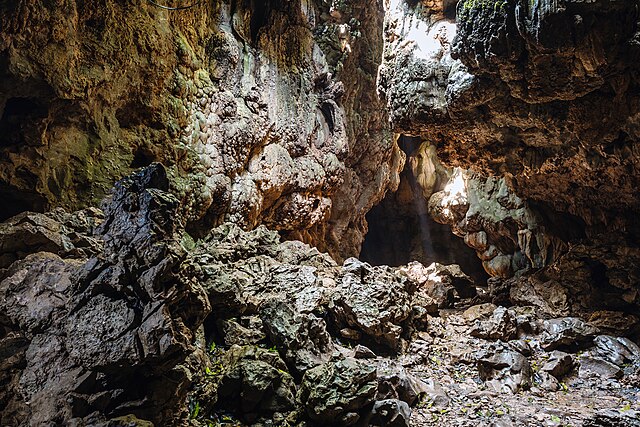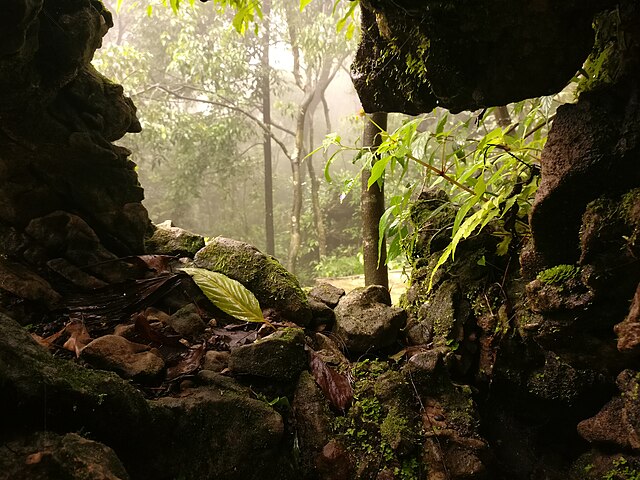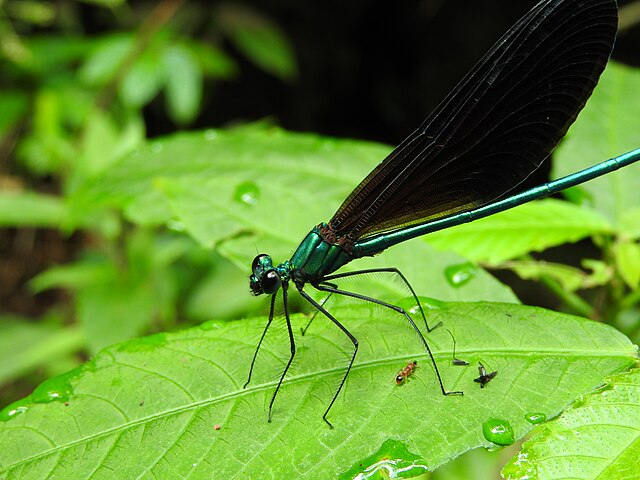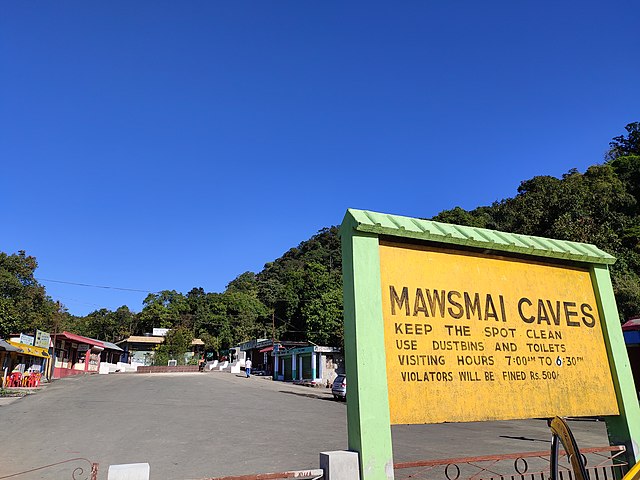Have you ever wondered what lies beneath the earth’s surface in one of India’s wettest regions? Mawsmai Cave, nestled in the heart of Meghalaya’s East Khasi Hills, offers an incredible underground adventure that’s surprisingly accessible to visitors of all ages. This natural limestone formation isn’t just another tourist spot – it’s a gateway to understanding the geological wonders that make Meghalaya truly unique.
Located just 6 kilometers from Cherrapunji, Mawsmai Cave stands as one of the most visitor-friendly caves in Northeast India. Unlike many cave systems that require technical expertise or extreme physical fitness, this natural wonder welcomes families, elderly visitors, and adventure seekers alike. But what exactly makes this cave so special, and why should it be on your Northeast India itinerary?
What Makes Mawsmai Cave Special?
Mawsmai Cave isn’t your typical underground cavern. This limestone marvel stretches approximately 150 meters in length, offering visitors a complete cave experience without the intimidation factor of more challenging spelunking adventures. The cave’s claim to fame lies in its perfect balance of accessibility and natural beauty – you get the thrill of cave exploration without needing specialized equipment or extreme physical preparation.
The cave system formed over millions of years through the patient work of water erosion on limestone bedrock. This process created the stunning stalactites and stalagmites that greet visitors today, along with unique rock formations that seem almost otherworldly in their beauty.
A Brief History of Mawsmai Cave
Local Khasi communities have known about Mawsmai Cave for generations, but it gained wider recognition only in recent decades as Meghalaya’s tourism industry developed. The name “Mawsmai” itself comes from the Khasi language, reflecting the deep cultural connections local tribes have with this natural formation.
Archaeological evidence suggests that these caves may have served various purposes for ancient communities, from shelter during monsoons to spiritual ceremonies. Today, the cave represents a bridge between Meghalaya’s rich cultural heritage and its growing reputation as an adventure tourism destination.
Geological Significance
From a geological perspective, Mawsmai Cave represents millions of years of natural architecture. The limestone formations here are part of the larger Shillong Plateau’s geological story, showcasing how water and time can create breathtaking underground landscapes. The cave’s formations continue to evolve, with mineral-rich water slowly adding to existing stalactites and stalagmites.
Scientists study caves like Mawsmai to understand regional geological processes, climate history, and groundwater patterns. For visitors, this means you’re not just exploring a tourist attraction – you’re walking through a natural museum of Earth’s history.
Location and How to Reach Mawsmai Cave
Mawsmai Cave sits strategically along the Shillong-Cherrapunji highway, making it easily accessible for travelers exploring Meghalaya’s famous attractions. The cave’s location at approximately 4,000 feet above sea level provides not only stunning underground experiences but also panoramic views of the surrounding hills and valleys.
The cave’s coordinates place it firmly within the East Khasi Hills district, specifically in the Sohra (Cherrapunji) region. This positioning makes it an ideal stop for travelers heading to or from other popular destinations like the Double Decker Living Root Bridge or Nohkalikai Falls.
Getting There from Shillong
The journey from Shillong to Mawsmai Cave covers approximately 54 kilometers and typically takes 1.5 to 2 hours by road. The route follows the scenic Shillong-Cherrapunji highway, offering breathtaking views of rolling hills, waterfalls, and traditional Khasi villages along the way.
Most travelers combine their Mawsmai Cave visit with a broader Cherrapunji sightseeing tour, which makes practical and economic sense. The well-maintained road connection means you can easily include the cave in a day trip from Shillong or use it as a starting point for exploring other Cherrapunji attractions.
Transportation Options
You have several transportation choices for reaching Mawsmai Cave. Private taxis remain the most popular option, offering flexibility in timing and the ability to combine multiple attractions in a single trip. Many local operators provide Cherrapunji tour packages that include Mawsmai Cave along with other must-see destinations.
Shared taxis and buses also connect Shillong to Cherrapunji, though these require more planning around fixed schedules. For the more adventurous, motorcycle rentals provide an exciting way to experience the scenic route, though weather conditions should be carefully considered, especially during monsoon months.
The Cave Experience: What to Expect Inside

Stepping into Mawsmai Cave feels like entering nature’s own cathedral. The temperature drops noticeably as you cross the threshold, providing welcome relief from Meghalaya’s tropical climate. Your eyes need a moment to adjust to the dim lighting, but once they do, you’ll be amazed by the intricate limestone formations surrounding you.
The cave experience unfolds in distinct phases, each offering unique perspectives on this underground wonder. Unlike some caves that require crawling or technical maneuvers, Mawsmai Cave allows most visitors to walk upright through the majority of the passage, though some sections do require ducking or careful navigation.
Cave Structure and Layout
Mawsmai Cave follows a generally linear path, making navigation straightforward for visitors. The cave doesn’t branch into complex tunnel systems that might confuse or disorient explorers. Instead, it offers a clear route from entrance to exit, with well-defined chambers and passages that showcase different geological features.
The cave’s structure includes several distinct zones, each with its own character and formations. This variety ensures that your underground journey remains engaging throughout, with new sights and formations appearing around each bend.
The Entrance Chamber
Your cave adventure begins in a spacious entrance chamber that serves as a natural acclimatization zone. Here, you’ll find some of the cave’s most impressive stalactite formations hanging like natural chandeliers from the ceiling. The entrance chamber also features information displays that help visitors understand what they’re seeing and the geological processes that created these formations.
This initial space provides excellent opportunities for photography, with natural light from the entrance creating dramatic contrasts with the cave’s darker recesses. Many visitors find themselves spending considerable time in this chamber, marveling at formations that took thousands of years to develop.
The Narrow Passages
As you progress deeper into the cave, passages become more intimate, requiring careful navigation in some sections. These narrower areas showcase the cave’s most delicate formations, where every surface tells a story of patient geological processes. The passages wind naturally through the limestone, creating a sense of adventure and discovery.
Don’t worry about getting claustrophobic – the passages, while narrow, maintain adequate headroom for most visitors, and the knowledge that you’re following a well-established route provides reassurance. These sections often feature the cave’s most unique formations, making the careful navigation worthwhile.
The Exit Point
Mawsmai Cave offers the unique feature of a separate exit point, meaning you don’t need to retrace your steps through the cave. This through-passage design enhances the sense of journey and discovery while preventing bottlenecks that might occur if all visitors used the same entrance and exit.
The exit provides a different perspective on the surrounding landscape, often surprising visitors with unexpected views of the Cherrapunji region. This design element makes Mawsmai Cave particularly visitor-friendly compared to dead-end cave systems.
Safety Features and Accessibility
Safety measures at Mawsmai Cave strike an excellent balance between preserving the natural experience and ensuring visitor security. Strategically placed lighting illuminates key sections without overwhelming the cave’s natural ambiance. Handrails and pathway markers help guide visitors through trickier sections while remaining unobtrusive.
The cave maintains its natural character while incorporating necessary safety elements. Emergency procedures are clearly posted, and local guides are available for visitors who prefer additional assistance or information during their exploration.
Best Time to Visit Mawsmai Cave
Timing your visit to Mawsmai Cave can significantly impact your experience. While the cave remains accessible year-round, external factors like weather, crowds, and regional attractions influence the ideal visiting periods. Understanding these patterns helps you plan a visit that maximizes both enjoyment and safety.
The cave’s internal temperature remains relatively constant throughout the year, typically staying cool and comfortable regardless of external weather conditions. However, accessing the cave and combining it with other regional attractions depends heavily on seasonal considerations.
Weather Considerations
Meghalaya’s climate directly affects your Mawsmai Cave experience, particularly regarding travel to and from the site. The region experiences heavy monsoons from June to September, which can make road travel challenging and limit visibility for scenic photography. However, monsoon season also brings the region’s waterfalls to their most spectacular levels.
Post-monsoon months from October to December offer excellent conditions for cave exploration, with clear skies, comfortable temperatures, and lush green landscapes. Winter months from January to February provide the clearest visibility and most comfortable outdoor conditions, though temperatures can be cooler.
Crowd Management Tips
Mawsmai Cave’s popularity means certain times attract larger crowds, potentially affecting your experience. Weekends and Indian holidays typically see the highest visitor numbers, which can lead to longer waiting times and more crowded conditions inside the cave.
Early morning visits, particularly on weekdays, often provide the most peaceful cave experience. If you’re planning a weekend visit, arriving early or later in the afternoon can help you avoid peak crowd periods while still allowing adequate time for exploration.
Essential Tips for Cave Exploration

Successful cave exploration requires some preparation, even for an accessible cave like Mawsmai. While you don’t need specialized caving equipment, certain preparations enhance both safety and enjoyment of your underground adventure. These practical tips come from experienced visitors and local guides who understand the cave’s unique characteristics.
Preparation doesn’t mean over-complication – Mawsmai Cave’s accessibility means most visitors can explore successfully with basic planning and appropriate expectations. However, understanding what to expect and how to prepare ensures you get the most from your visit.
What to Wear
Appropriate clothing for Mawsmai Cave exploration differs significantly from typical tourist attire. The cave’s internal environment, combined with potential water drips and uneven surfaces, requires practical clothing choices that prioritize comfort and safety over fashion.
Sturdy, closed-toe shoes with good grip are absolutely essential – the cave floor can be slippery, and protecting your feet from rocks and potential water is crucial. Lightweight, long-sleeved clothing helps protect against minor scrapes while providing warmth in the cave’s cooler environment. Avoid wearing white or light-colored clothing, as cave exploration inevitably involves some contact with rock surfaces.
Photography Guidelines
Photography inside Mawsmai Cave presents both opportunities and challenges. The cave’s dramatic formations create stunning photo opportunities, but lighting conditions require some technical consideration. Natural light near the entrance provides excellent illumination for initial photos, but deeper sections require flash or high-ISO camera settings.
Respect for other visitors and the cave environment should guide your photography approach. Avoid using bright continuous lights that might disturb other explorers, and be mindful of group dynamics when stopping for photos in narrow passages. Many visitors find that the cave’s most memorable moments are best experienced rather than photographed.
Nearby Attractions and Activities
Mawsmai Cave’s location in the Cherrapunji region places it at the heart of some of Meghalaya’s most spectacular attractions. Smart travelers use the cave as part of a broader exploration strategy, combining underground adventure with waterfalls, living root bridges, and cultural experiences that showcase the region’s diversity.
The concentrated nature of Cherrapunji’s attractions means you can experience dramatically different environments – from underground limestone formations to thundering waterfalls – within a relatively small geographic area.
Cherrapunji Sightseeing
Cherrapunji’s reputation as one of the world’s wettest places has created a unique landscape where water has carved extraordinary features into the earth. Beyond Mawsmai Cave, visitors can explore Nohkalikai Falls, the Seven Sisters Falls, and the Eco Park, each offering different perspectives on how water shapes this remarkable region.
The town itself provides insights into how communities adapt to extreme rainfall, with traditional Khasi architecture and agricultural practices that work with, rather than against, the challenging climate. Local markets and restaurants offer opportunities to experience authentic Khasi culture and cuisine.
Other Caves in the Region
While Mawsmai Cave offers the most accessible cave experience in the region, several other cave systems provide different levels of adventure for more ambitious explorers. Arwah Cave, located nearby, offers a more challenging experience with deeper passages and more technical sections.
For serious cavers, the region includes several undeveloped cave systems that require guides and proper equipment. However, most visitors find that Mawsmai Cave provides a perfect introduction to Meghalaya’s underground wonders without requiring extreme adventure credentials.
Accommodation Options Near Mawsmai Cave
Staying near Mawsmai Cave allows you to maximize your time exploring the Cherrapunji region while minimizing travel time from distant accommodations. The area offers various lodging options, from budget guesthouses to more comfortable hotels, though availability can be limited during peak tourist seasons.
Most accommodations in the Cherrapunji area cater to domestic tourists, with basic but clean facilities and local hospitality. Booking in advance, particularly during festival periods or pleasant weather months, ensures you’ll have accommodation that meets your needs and budget.
Cultural Significance for the Khasi People
For the indigenous Khasi community, Mawsmai Cave represents more than a tourist attraction – it’s part of their ancestral landscape and cultural heritage. Understanding this cultural dimension adds depth to your visit, transforming a simple cave exploration into a meaningful cultural exchange.
Traditional Khasi beliefs often attribute spiritual significance to natural formations like caves, considering them dwelling places of spirits or ancestors. While modern tourism has changed how the cave is used and perceived, these cultural connections remain important to local communities.
Respectful visitors acknowledge this cultural significance by treating the cave and surrounding environment with appropriate reverence, supporting local guides and businesses, and learning about Khasi traditions and beliefs that have shaped the region’s character.
Conservation Efforts and Environmental Impact

Tourism to Mawsmai Cave brings both opportunities and challenges for environmental conservation. Increased visitor numbers provide economic incentives for preservation while potentially threatening the delicate cave ecosystem through human impact. Understanding these dynamics helps visitors make responsible choices that support conservation efforts.
Current conservation efforts focus on balancing accessibility with protection, implementing visitor guidelines that minimize environmental impact while maintaining the cave’s appeal as a tourist destination. These efforts include limiting group sizes during peak periods, maintaining designated pathways, and educating visitors about cave ecology.
Responsible tourism practices – such as not touching formations, properly disposing of waste, and following designated routes – help ensure that future generations can enjoy Mawsmai Cave in its current pristine condition. Your individual choices as a visitor contribute to the cave’s long-term preservation.
Conclusion
Mawsmai Cave stands as a testament to nature’s patient artistry and Meghalaya’s incredible geological diversity. This accessible underground wonder offers visitors a perfect introduction to cave exploration, combining adventure with safety, natural beauty with cultural significance. Whether you’re a family looking for a unique experience, an adventure seeker wanting to explore underground landscapes, or a traveler interested in understanding Meghalaya’s natural heritage, Mawsmai Cave delivers an unforgettable experience.
The cave’s location near Cherrapunji makes it an ideal component of a broader Northeast India adventure, while its accessibility ensures that age and fitness level don’t prevent anyone from experiencing this natural wonder. As you plan your visit, remember that Mawsmai Cave represents not just a tourist destination, but a living piece of Earth’s history and an important part of Khasi cultural heritage.
Your journey through Mawsmai Cave will leave you with a deeper appreciation for the natural forces that shape our world and the importance of preserving these incredible formations for future generations. It’s more than just a cave – it’s a gateway to understanding the remarkable geological and cultural richness that makes Meghalaya truly special.
FAQs
Q1: How long does it take to explore Mawsmai Cave completely? Most visitors spend 30-45 minutes exploring Mawsmai Cave from entrance to exit. This timing allows for careful navigation, photography opportunities, and appreciation of the various formations without feeling rushed. Groups with elderly members or those stopping frequently for photos might take up to an hour.
Q2: Is Mawsmai Cave suitable for children and elderly visitors? Yes, Mawsmai Cave is designed to be accessible for most age groups. While some sections require ducking or careful navigation, children above 5 years and reasonably mobile elderly visitors can explore the cave successfully. The separate entrance and exit points eliminate the need to retrace steps, making the journey less tiring.
Q3: Do I need a guide to explore Mawsmai Cave? While Mawsmai Cave can be explored independently due to its straightforward layout and safety features, hiring a local guide enhances the experience significantly. Guides provide geological information, cultural context, and ensure you don’t miss important formations. They’re particularly valuable for photography tips and safety assistance.
Q4: What should I do if I feel claustrophobic inside the cave? Mawsmai Cave’s design minimizes claustrophobic feelings with adequate headroom in most sections and the knowledge that you’re following a through-passage rather than entering a dead-end system. If you feel uncomfortable, communicate with your group, take deep breaths, and remember that the exit is always ahead, not behind you.
Q5: Can I visit Mawsmai Cave during monsoon season? While Mawsmai Cave remains accessible during monsoon season, heavy rains can make road travel challenging and increase water dripping inside the cave. The cave itself stays safe, but external conditions might affect your overall travel experience. If visiting during monsoons, check weather conditions and road status before traveling.

